height MERCEDES-BENZ CLA 2018 Owners Manual
[x] Cancel search | Manufacturer: MERCEDES-BENZ, Model Year: 2018, Model line: CLA, Model: MERCEDES-BENZ CLA 2018Pages: 326, PDF Size: 7.97 MB
Page 18 of 326
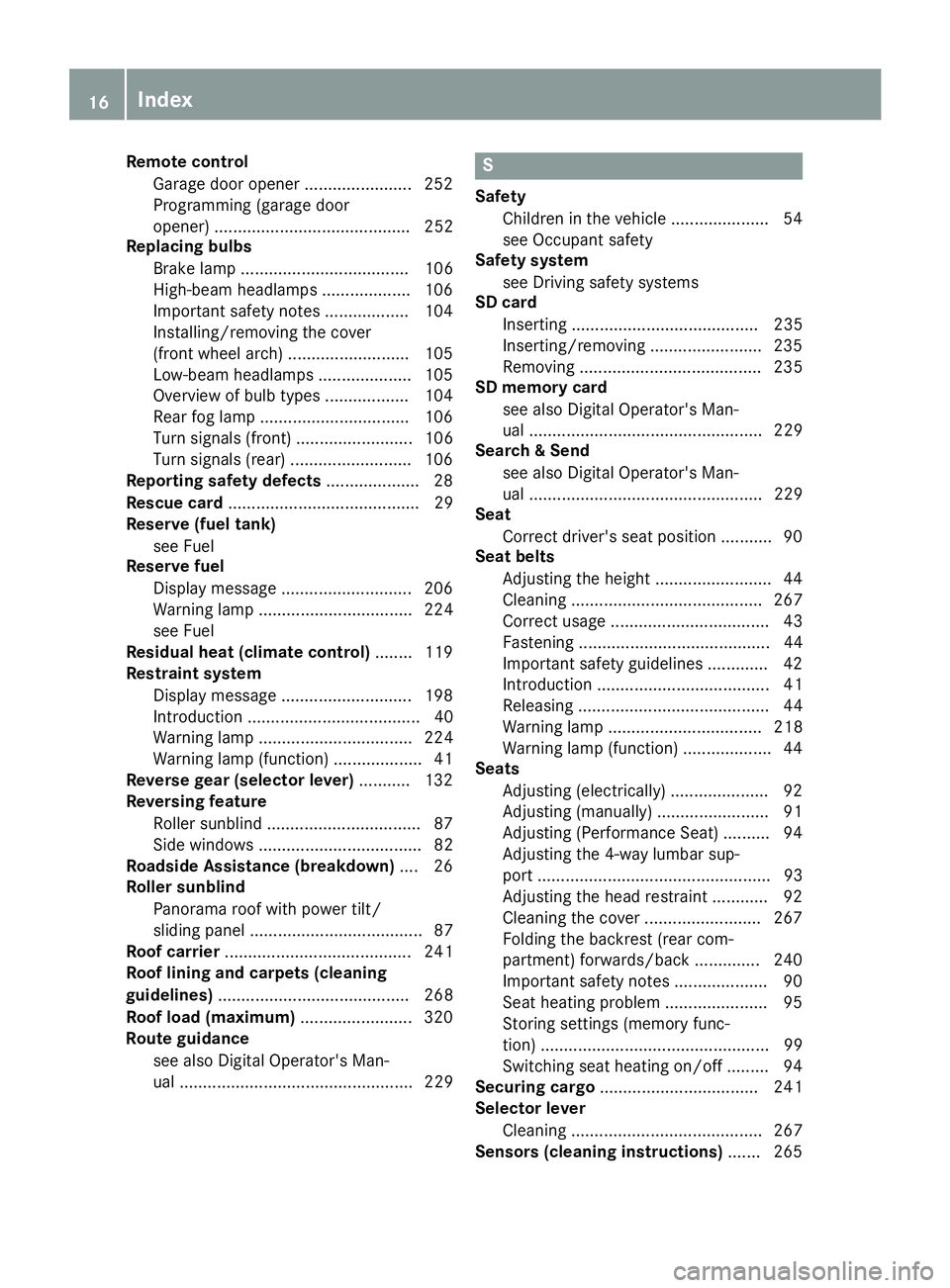
Remote control
Garag ed oo ro pener ....................... 252
Programming (garag ed oor
opener) .......................................... 252
Replacing bulbs
Brake lamp .................................... 106
High-beam headlamp s. .................. 106
Important safety notes .................. 104
Installing/removing the cover
(front whee la rch ). ......................... 105
Low-bea mh eadlamp s. ................... 105
Overview of bulb types .................. 104
Rear fog lamp ................................ 106
Turn signal s( front) ......................... 106
Turn signal s( rear) .......................... 106
Reporting safety defects .................... 28
Rescue card ......................................... 29
Reserve (fuel tank)
see Fuel
Reserve fuel
Displa ym essage ............................ 206
Warning lamp ................................. 224
see Fuel
Residual hea t( clim ate control) ........ 119
Restrain ts ystem
Displa ym essage ............................ 198
Introduction ..................................... 40
Warning lamp ................................. 224
Warning lamp (function) ................... 41
Revers eg ea r( selecto rl ever ) ........... 132
Reversin gf eature
Roller sunblind ................................. 87
Sid ew in dow s. .................................. 82
Roadside Assistance (breakdown) .... 26
Rolle rs unblind
Panorama roo fw it hp ower tilt/
sliding panel ..................................... 87
Roo fc arrier ........................................ 241
Roo fl inin ga nd carpets (cleaning
guidelines) ......................................... 268
Roo fl oa d( maximum) ........................ 320
Route guidance
see also Digital Operator's Man-
ua l. ................................................. 229 S Safety
Childre nint he vehicl e. .................... 54
see Occupant safety
Safety system
see Driving safety systems
SD card
Inserting ........................................ 235
Inserting/removing ........................ 235
Removing ....................................... 235
SD memory card
see also Digital Operator's Man-
ua l. ................................................. 229
Search &S en d
see also Digital Operator's Man-
ua l. ................................................. 229
Seat
Correct driver' ss ea tp osition ........... 90
Seat belts
Adjusting the height ......................... 44
Cleaning ......................................... 267
Correct usag e. ................................. 43
Fastening ......................................... 44
Important safety guideline s. ............ 42
Introduction ..................................... 41
Releasing ......................................... 44
Warning lamp ................................. 218
Warning lamp (function) ................... 44
Seats
Adjusting (electrically) ..................... 92
Adjusting (manually) ........................ 91
Adjusting (Performance Seat) .......... 94
Adjusting the 4-wa yl um ba rs up -
por t. ................................................. 93
Adjusting the hea dr estraint ............ 92
Cleaning the cove r. ........................ 267
Folding the backres t( rear com-
partment) forwards/back .............. 240
Important safety notes .................... 90
Sea th eating problem ...................... 95
Storing settings (memory func-
tion) ................................................. 99
Switching sea th eating on/of f. ........ 94
Securing cargo .................................. 241
Selecto rl ever
Cleaning ......................................... 267
Sensors (cleaning instructions) ....... 26516
Index
Page 45 of 326

If ac hild younger than twelve years old and
under 5ft( 1.5 0m)inh eight is travelin gint he
vehicle: R
always secur et he child in ac hild restraint
system suitable for this Mercedes-Ben zv ehi-
cle. The child restraint system must be appro-
priat etot he age, weight and size of the childR
always observe the instructions and safety
notes on "Children in the vehicle"
( Y
page 54) in addition to the child restraint
system manufacturer' si nstallation and oper-
atin gi nstructionsR
always observe the instructions and safety
notes on the "Occupant classification system
(OCS)" ( Y
page 47)
G WARNING
The seat belts may not perform their intended
protective function if: R
the ya re damaged, modified, extremely
dirty, bleache dord yedR
the seat belt buckle is damaged or
extremely dirty R
the Emergency Tensionin gD evices, belt
anchorage sori nertia reels have been modi-
fied.
Seat belts may be damaged in an accident,
althoug ht he damage may not be visible, e.g.
due to splinters of glass. Modifie dord amaged
seat belts may tear or fail, e.g. in an accident.
Modifie dE me rgency Tensionin gD evices
could accidentally trigger or fail to deploy
when necessary. This poses an increased risk
of injury or even fatal injury.
Never modif yt he seat belts ,E me rgency Ten-
sioning Devices, belt anchorage sa nd inertia
reels. Make sure that the seat belts are
undamaged, not worn out and clean .F ollow-
ing an accident ,h ave the seat belts checked
immediately at aq ualified specialist work-
shop.
Only use seat belts that have been approved for
your vehicle by Mercedes-Benz.
Sports seat or AMG Performance seat: this
seat is designed for the standard three-point
seat belt. If you install another multi-point seat
belt, e.g. sport or racin gs eat belts ,t he restraint system cannot provide the best level of protec-
tion.
G WARNING
If you feed seat belts through the opening in
the seat backrest ,t he seat backrest may be
damaged or may even break in the even tofa n
accident .T his poses an increased risk of
injury or even fatal injury.
Only use the standard three-point seat belt.
Never modif yt he seat belt system.
Proper use of th es eat beltsObserve the safet yn otes on the seat belt
( Y
page 42).
All vehicle occupant sm ust be wearin gt he seat
belt correctly befor eb eginnin gt he journey. Also
make sure that all vehicle occupant sa re always
wearing the seat belt correctly while the vehicle
is in motion.
When fastenin gt he seat belt, always make sure
that: R
the seat belt buckle tongue is inserted only
int ot he belt buckle belonging to that seat R
the seat belt is pulled tigh ta cross your body
Avoid wearing bulky clothing ,e .g. aw inter
coat. R
the seat belt is not twisted
Only the nc an the forces which occur be dis-
tributed over the area of the belt. R
the shoulder section of the belt is routed
across the center of your shoulder
The shoulder section of the seat belt should
not touc hy our nec korber outed under your
arm or behin dy our back .W here possible,
adjust the seat belt to the appropriate height. R
the lap belt is taut and passes across your lap
as low down as possible
The lap belt must always be routed across
your hip joints and not across your abdomen.
This applies particularly to pregnant women.
If necessary, push the lap belt down to your
hip join ta nd pull it tigh tu sing the shoulder
section of the belt. R
the seat belt is not routed across sharp, poin-
ted or fragile objects
If you have such item sl ocated on or in your
clothing ,e .g. pens ,k eys or eyeglasses ,s tore
these in as uitable place. R
only one perso nisu sing as eat beltOccupant safety 43
Safety Z
Page 47 of 326
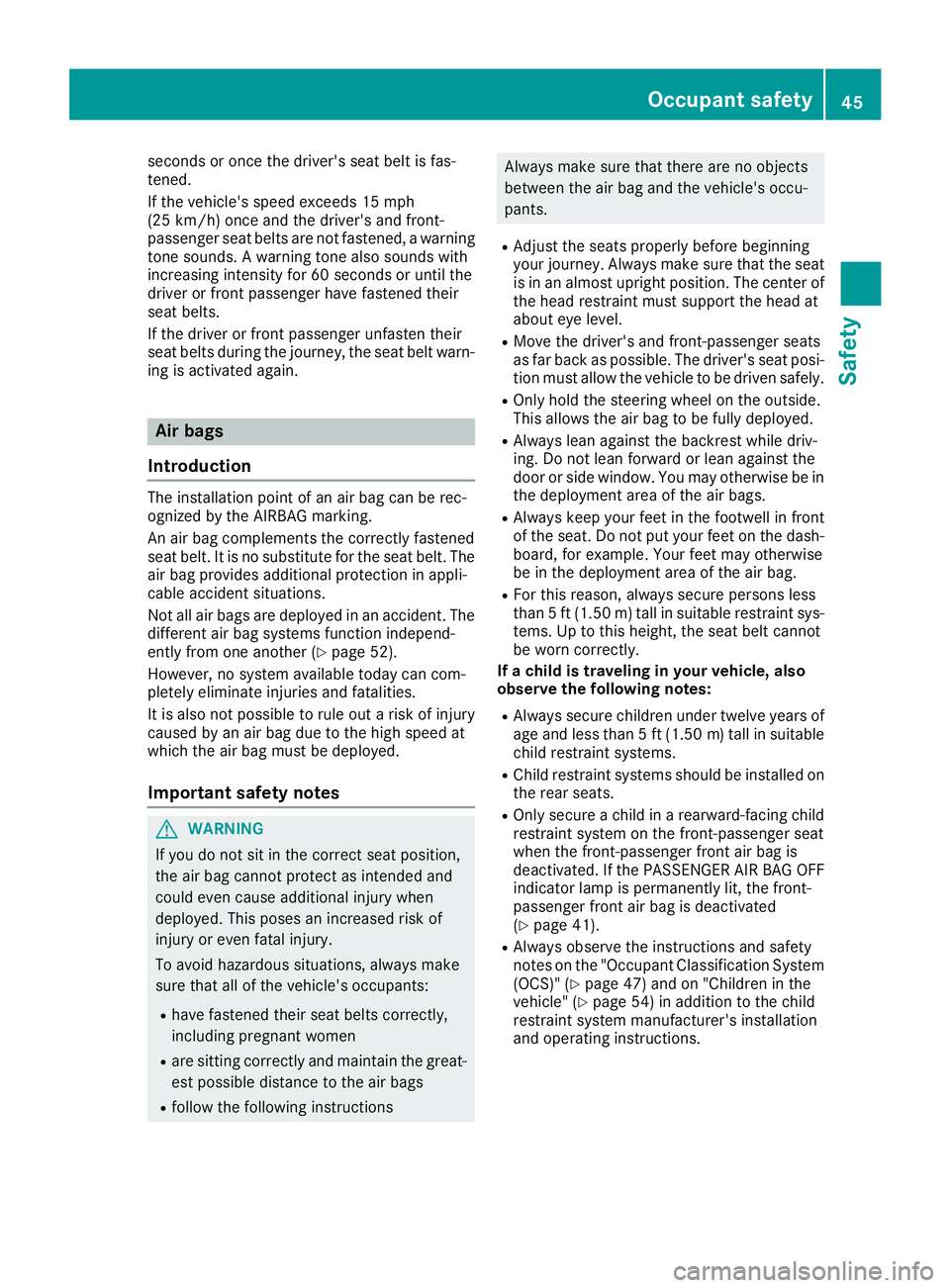
seconds or once the driver's seat belt is fas-
tened.
If the vehicle's speed exceeds 15 mph
(25 km/h) once and the driver's and front-
passenger seat belts are not fastened, aw arning
tone sounds. Aw arning tone also sounds with
increasing intensit yf or 60 seconds or until the
driver or front passenger have fastened their
seat belts.
If the driver or front passenger unfasten their
seat belts during the journey, the seat belt warn-
ing is activated again.
Air bags
Introduction The installation point of an air bag can be rec-
ognized by the AIRBAG marking.
An air bag complements the correctly fastened
seat belt. It is no substitute for the seat belt. The
air bag provides additional protection in appli-
cable accident situations.
Not all air bags are deployed in an accident. The
different air bag systems function independ-
ently from one another ( Y
page 52).
However, no system available today can com-
pletely eliminate injuries and fatalities.
It is also not possible to rule out ar isk of injury
caused by an air bag due to the high speed at
which the air bag must be deployed.
Important safety notes
G WARNING
If you do not sit in the correct seat position,
the air bag cannot protect as intended and
could even cause additional injury when
deployed. This poses an increased risk of
injury or even fatal injury.
To avoid hazardous situations, always make
sure that all of the vehicle's occupants: R
have fastened their seat belts correctly,
including pregnant women R
are sitting correctly and maintain the great-
est possible distance to the air bags R
follow the following instructions Always make sure that there are no objects
between the air bag and the vehicle's occu-
pants. R
Adjust the seats properly before beginning
your journey. Always make sure that the seat
is in an almost upright position. The center of
the head restraint must support the head at
about eye level. R
Move the driver's and front-passenger seats
as far back as possible .T he driver's seat posi-
tion must allow the vehicle to be driven safely. R
Only hold the steering wheel on the outside.
This allow st he air bag to be fully deployed. R
Always lean against the backrest while driv-
ing. Do not lean forward or lean against the
door or side window. You may otherwise be in
the deployment area of the air bags. R
Always keep your feet in the footwell in front
of the seat. Do not put your feet on the dash-
board, for example. Your feet may otherwise
be in the deployment area of the air bag. R
For this reason, always secure persons less
than 5f t( 1.50 m) tall in suitable restraint sys-
tems. Up to this height, the seat belt cannot
be worn correctly.
If ac hild is traveling in your vehicle ,a lso
observe the following notes: R
Always secure children under twelve years of
age and less than 5f t( 1.50 m) tal lins ui table
child restraint systems. R
Chil dr estraint systems shoul dbei nstalle do n
the rea rs ea ts. R
Onl ys ec ur eac hild in ar earward-facing child
restraint syste mont he front-passenge rs ea t
when the front-passenge rf ront ai rb ag is
deactivated .Ift he PASSENGER AIR BAG OFF
indicator lamp is permanentl yl it ,t he front-
passenge rf ront ai rb ag is deactivated
( Y
page 41). R
Alway so bser ve the instructions and safety
note sont he "Occupant Classification Syste m
( OCS) "( Y
page 47) and on "Children in the
vehicle" ( Y
page 54 )i na ddit io ntot he child
restraint syste mm an ufacturer's installation
and operating instructions.Occupant safety 45
Safety Z
Page 56 of 326
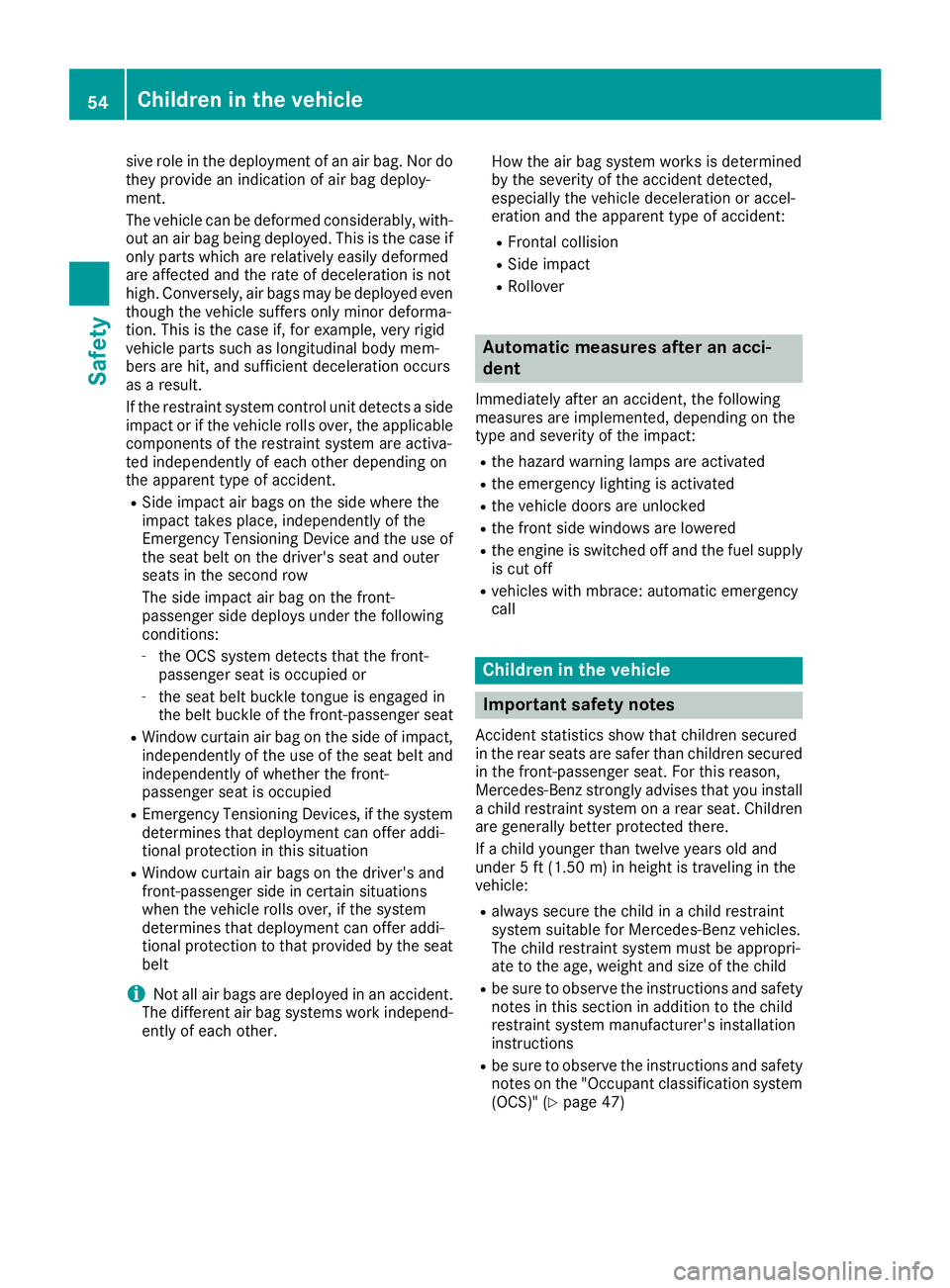
sive role in the deployment of an air bag. Nor do
they provide an indication of air bag deploy-
ment.
The vehicle can be deformed considerably, with-
out an air bag being deployed. This is the case if
only parts which are relatively easil yd eformed
are affected and the rate of deceleration is not
high. Conversely, air bags may be deployed even
though the vehicle suffers only minor deforma-
tion. This is the case if, for example, very rigid
vehicle parts such as longitudinal body mem-
bers are hit, and sufficient deceleration occurs
as ar esult.
If the restraint system control unit detects as ide
impact or if the vehicle rolls over, the applicable
component soft he restraint system are activa-
ted independently of each other depending on
the apparent type of accident. R
Side impact air bags on the side where the
impact takes place, independently of the
Emergenc yT ensioning Device and the use of
the seat belt on the driver's seat and outer
seats in the second row
The side impact air bag on the front-
passenger side deploy su nder the following
conditions: -
the OCS system detects that the front-
passenger seat is occupied or -
the seat belt buckle tongue is engaged in
the belt buckle of the front-passenger seat R
Window curtain air bag on the side of impact,
independently of the use of the seat belt and
independently of whether the front-
passenger seat is occupied R
Emergenc yT ensioning Devices, if the system
determines that deployment can offer addi-
tional protection in this situation R
Window curtain air bags on the driver's and
front-passenger side in certain situations
when the vehicle rolls over, if the system
determines that deployment can offer addi-
tional protection to that provided by the seat
belt
i Not all air bags are deployed in an accident.
The different air bag systems work independ-
ently of each other. How the air bag system works is determined
by the severity of the accident detected,
especially the vehicle deceleration or accel-
eration and the apparent type of accident: R
Frontal collision R
Side impact R
Rollover
Automatic measures after an acci-
dent Immediately after an accident, the following
measures are implemented, depending on the
type and severity of the impact: R
the hazard warning lamps are activated R
the emergency lighting is activated R
the vehicle doors are unlocked R
the front side windows are lowered R
the engine is switched off and the fuel supply
is cut off R
vehicles with mbrace: automatic emergency
call
Children in the vehicle
Important safety notes Accident statistics show that children secured
in the rear seats are safer than children secured
in the front-passenger seat. For this reason,
Mercedes-Benz strongly advises that you install
ac hild restraint system on ar ear seat. Children
are generally better protected there.
If ac hild younger than twelve years old and
under 5ft( 1.50 m) in height is traveling in the
vehicle: R
always secure the child in ac hild restraint
system suitable for Mercedes-Benz vehicles.
The child restraint system must be appropri-
ate to the age, weight and size of the child R
be sure to observe the instructions and safety
notes in this section in addition to the child
restraint system manufacturer's installation
instructions R
be sure to observe the instructions and safety
notes on the "Occupant classification system
(OCS)" ( Y
page 47)54
Children in the vehicle
Safety
Page 93 of 326
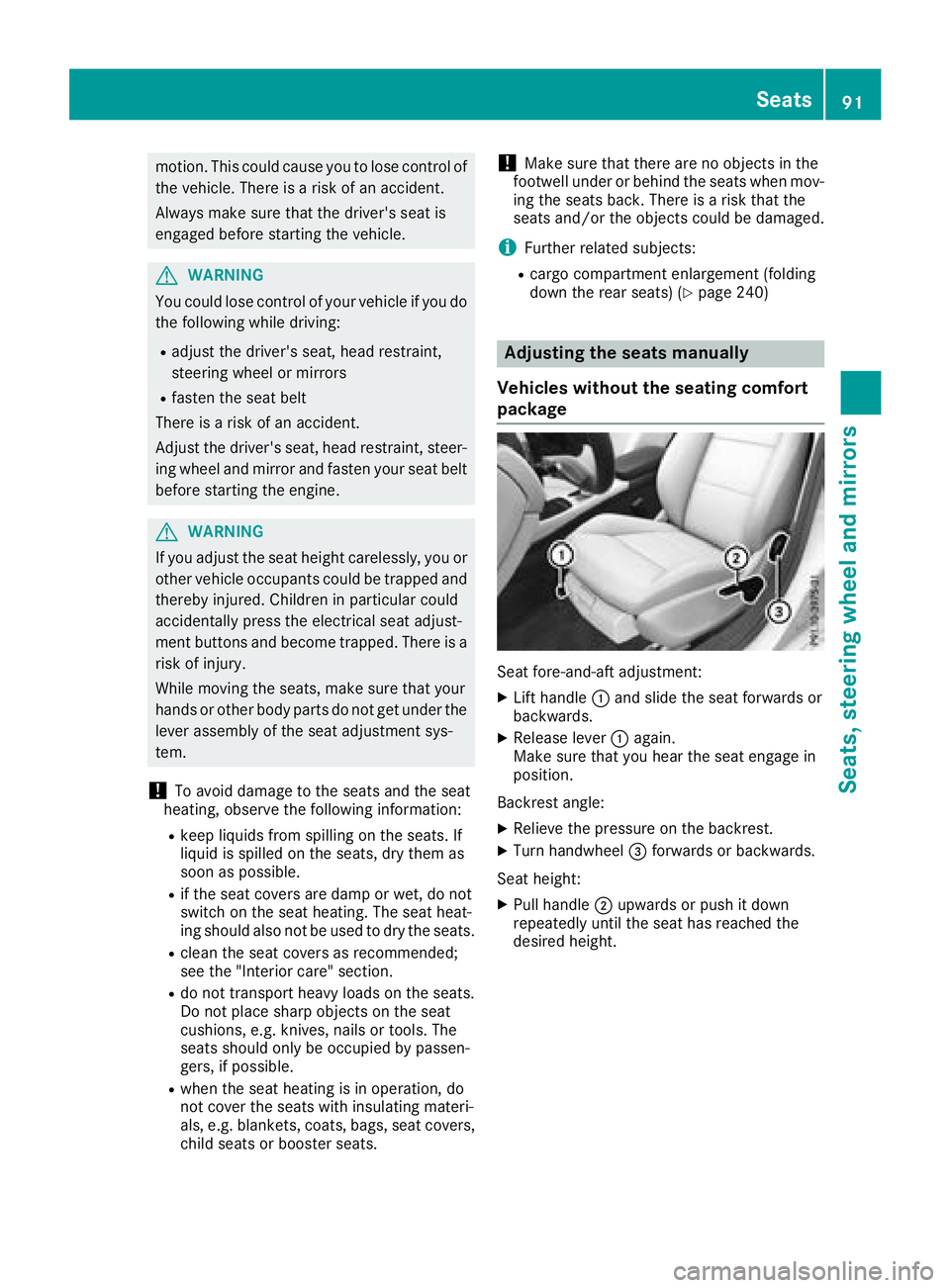
motion. This could cause you to lose control of
the vehicle. There is ar isk of an accident.
Always make sure that the driver' ss eat is
engage db efore starting the vehicle.
G WARNING
You could lose control of you rv ehicl eify ou do
the following while driving: R
adjust the driver' ss eat, head restraint,
steering whee lorm irrorsR
fasten the seat belt
There is ar isk of an accident.
Adjust the driver' ss eat, head restraint, steer-
ing whee la nd mirror and fasten you rs eat belt
before starting the engine.
G WARNING
If you adjust the seat height carelessly ,y ou or
other vehicl eo ccupants could be trappe da nd
thereby injured. Children in particular could
accidentally press the electrica ls eat adjust-
ment buttons and become trapped. There is a
risk of injury.
Whil em oving the seats, make sure that your
hands or other body parts do not get under the
lever assembly of the seat adjustment sys-
tem.
! To avoi dd amage to the seats and the seat
heating, observe the following information: R
keep liquid sf rom spilling on the seats. If
liquid is spilled on the seats, dry them as
soon as possible. R
if the seat covers are damp or wet, do not
switch on the seat heating. The seat heat-
ing should als on ot be used to dry the seats.R
clean the seat covers as recommended;
see the "Interior care" section. R
do not transport heavy loads on the seats.
Do not place sharp objects on the seat
cushions, e.g. knives, nail sort ools. The
seats should only be occupied by passen-
gers, if possible. R
when the seat heating is in operation, do
not cover the seats with insulating materi-
als ,e .g. blankets, coats, bags ,s eat covers,
child seats or booster seats. ! Make sure that there are no objects in the
footwel lu nder or behind the seats when mov-
ing the seats back. There is ar isk that the
seats and/or the objects could be damaged.
i Further related subjects: R
cargo compartment enlargement (folding
down the rear seats) ( Y
page 240)
Adjusting the seats manually
Vehicles without the seating comfort
package
Seat fore-and-aft adjustment: X
Lift handle �C and slid et he seat forwards or
backwards. X
Release lever �C again.
Make sure that you hear the seat engage in
position.
Backrest angle: X
Relieve the pressure on the backrest. X
Turn handwheel �
Page 95 of 326
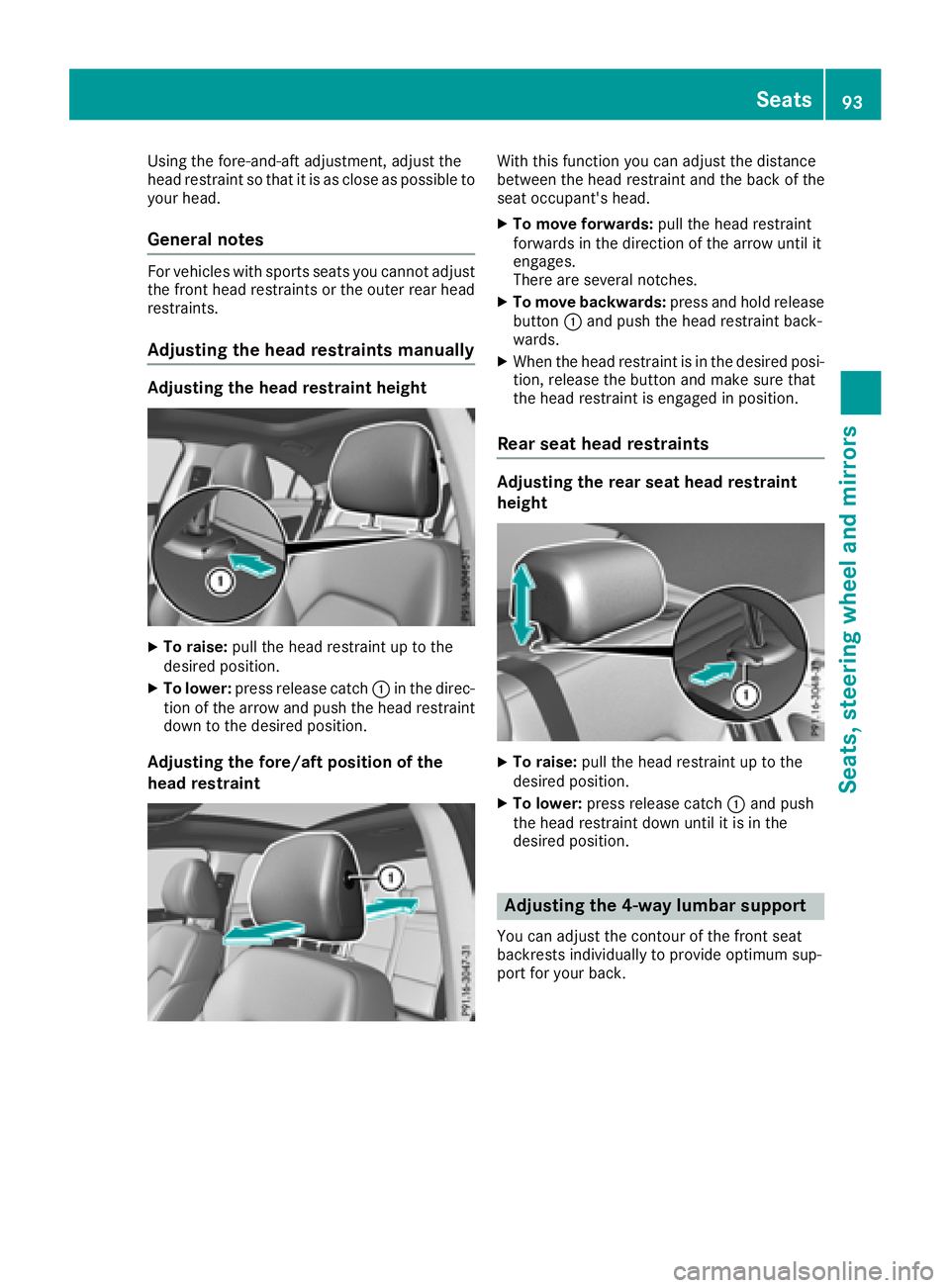
Using the fore-and-aft adjustment, adjust the
head restraint so that it is as close as possible to
your head.
General notes For vehicles with sports seats you cannot adjust
the front head restraints or the outer rear head
restraints.
Adjusting the head restraints manually Adjusting the head restraint height
X
To raise: pull the head restraint up to the
desired position. X
To lower: press release catch �C in the direc-
tion of the arrow and push the head restraint
down to the desired position.
Adjusting the fore/aft position of the
head restraint With this function you can adjust the distance
between the head restraint and the back of the
seat occupant's head. X
To move forwards: pull the head restraint
forwards in the direction of the arrow until it
engages.
There are several notches. X
To move backwards: press and hold release
button �C and push the head restraint back-
wards. X
When the head restraint is in the desired posi-
tion, release the button and make sure that
the head restraint is engaged in position.
Rear seat head restraints Adjusting the rear seat head restraint
height
X
To raise: pull the head restraint up to the
desired position. X
To lower: press release catch �C and push
the head restraint down until it is in the
desired position.
Adjusting the 4-way lumbar support You can adjust the contour of the front seat
backrests individually to provide optimum sup-
port for your back. Seats 93
Seats, steering whee la nd mirrors Z
Page 97 of 326

Problems with the seat heating Problem
Possible causes/consequences and �P Solutions
The seat heating has
switched off prematurely
or cannot be switched
on. The on-board voltage is too low because too many electrical consum-
ers are switched on. X
Switch off electrical consumers that you do not need, such as the
rear window defroster or interior lighting.
Once the battery is sufficiently charged, the seat heating will switch
back on automatically.
Steering wheel
Important safety notes
G WARNING
You could lose control of your vehicle if you do
the following while driving: R
adjust the driver's seat, head restraint,
steering wheel or mirrors R
fasten the seat belt
There is ar isk of an accident.
Adjust the driver's seat, head restraint ,s teer-
ing wheel and mirror and fasten your seat belt
before startin gt he engine.
G WARNING
Children could injure themselves if they
adjust the steering wheel. There is ar isk of
injury.
When leaving the vehicle, always take the
SmartKey with you and lock the vehicle. Never
leave children unsupervised in the vehicle.
Adjusting the steering wheel
G WARNING
If the steering wheel is unlocked while the
vehicle is in motion, it could change position
unexpectedly. This could cause you to lose
control of the vehicle. There is ar isk of an
accident.
Before startin go ff, make sure the steering
wheel is locked. Never unlock the steering
wheel while the vehicle is in motion. �C
Release lever �D
Adjust st he steering wheel height�
Page 309 of 326
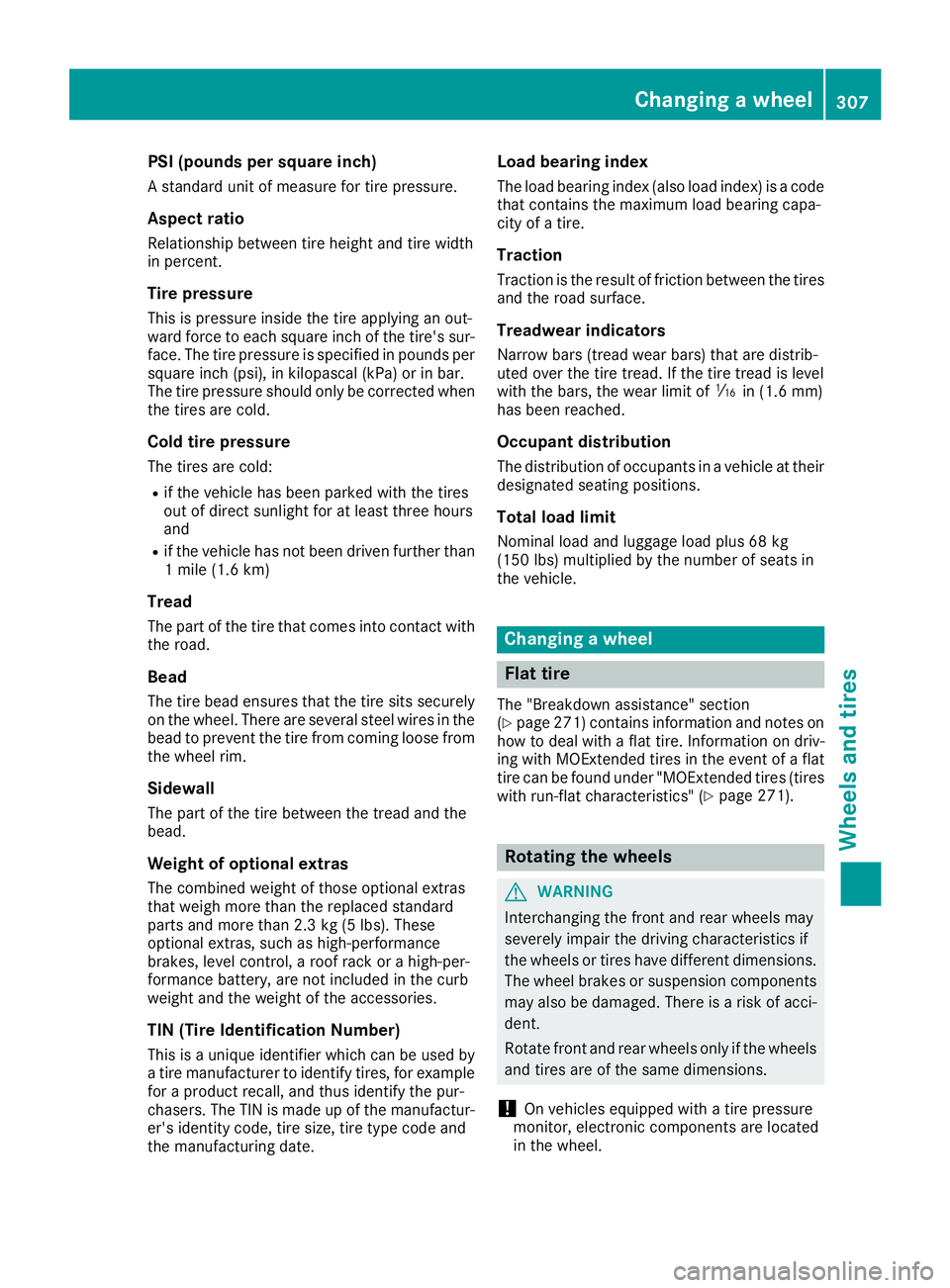
PSI (pounds per squar ei nch)As tandard unit of measure for tire pressure.
Aspect ratio Relationship between tire height and tire width
in percent.
Tire pressure This is pressure inside the tire applying an out-
ward force to each square inch of the tire's sur-
face. The tire pressure is specified in pounds per
square inch (psi), in kilopascal (kPa) or in bar.
The tire pressure should only be corrected when
the tires are cold.
Cold tire pressure The tires are cold: R
if the vehicle has been parked with the tires
out of direct sunlight for at least three hours
and R
if the vehicle has not been driven further than
1m ile (1.6 km)
Tread The part of the tire that comes into contact with
the road.
Bead The tire bead ensures that the tire sits securely
on the wheel. There are several steel wires in the
bead to prevent the tire from coming loose from
the wheel rim.
Sidewall The part of the tire between the tread and the
bead.
Weight of optional extras
The combined weight of those optional extras
that weigh more than the replaced standard
parts and more than 2.3 kg (5 lbs). These
optional extras, such as high-performance
brakes, level control, ar oof rack or ah igh-per-
formanc eb attery, are not included in the curb
weight and the weight of the accessories.
TIN (Tire Identification Number)
This is au nique identifier which can be used by
at ire manufacturer to identify tires, for example
for ap roduct recall, and thus identify the pur-
chasers. The TIN is made up of the manufactur-
er's identity code, tire size, tire type code and
the manufacturing date. Load bearing index The load bearing index (also load index) is ac ode
that contains the maximum load bearing capa-
city of at ire.
Traction Traction is the result of friction between the tires
and the road surface.
Treadwear indicators Narrow bars (tread wear bars) that are distrib-
uted over the tire tread. If the tire tread is level
with the bars, the wear limit of �
Page 323 of 326
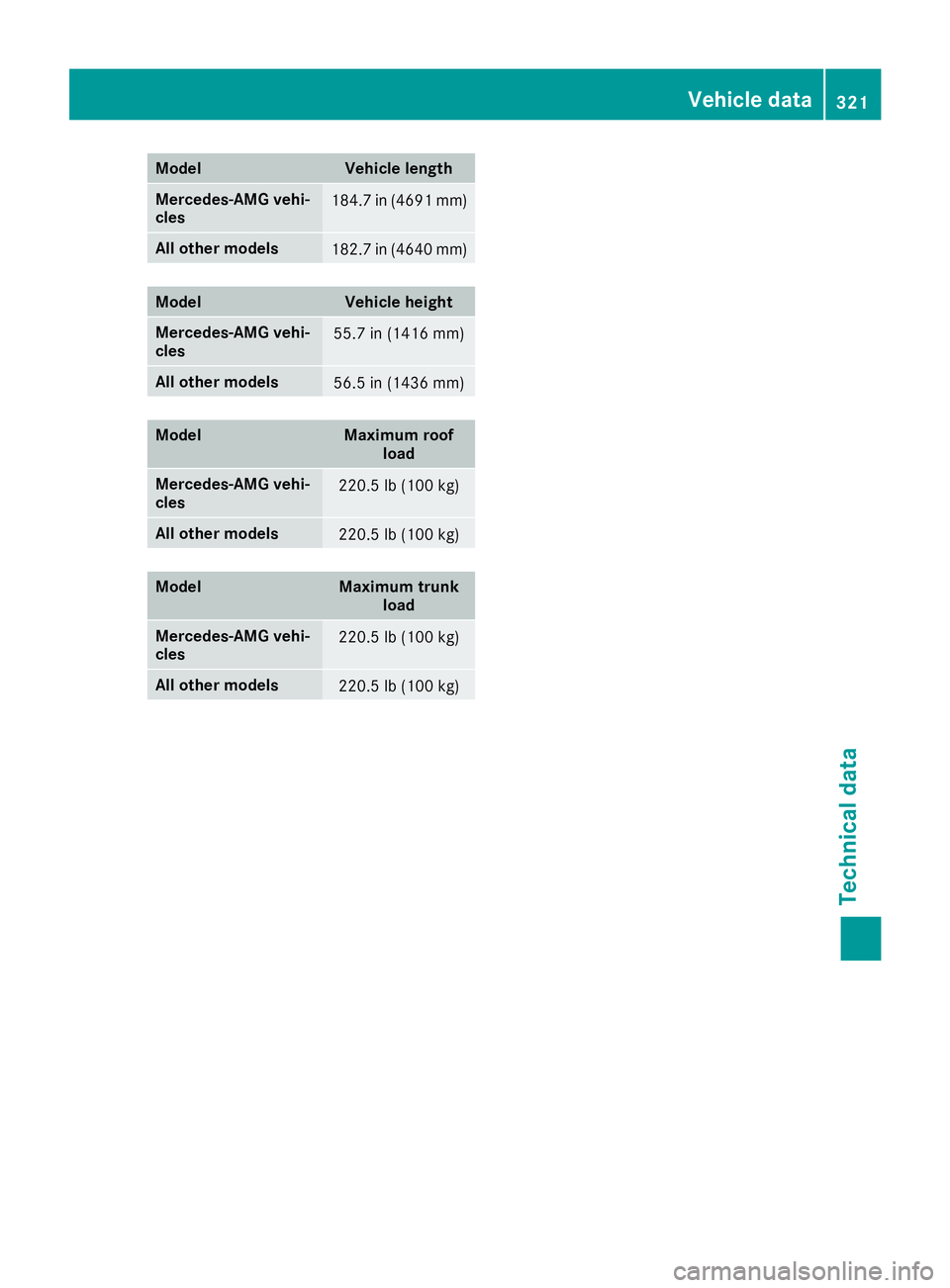
Model Vehicle length
Mercedes ‑ AM Gv ehi-
cles 184.7 in (4691 mm)
All other models
182.7 in (4640 mm)
Model Vehicle height
Mercedes ‑ AM Gv ehi-
cles 55.7 in (1416 mm)
All other models
56.5 in (1436 mm)
Model Maximum roof
load
Mercedes ‑ AM Gv ehi-
cles 220.5 lb (100 kg)
All other models
220.5 lb (100 kg)
Model Maximum trunk
load
Mercedes ‑ AM Gv ehi-
cles 220.5 lb (100 kg)
All other models
220.5 lb (100 kg) Vehicle data 321
Technical data Z